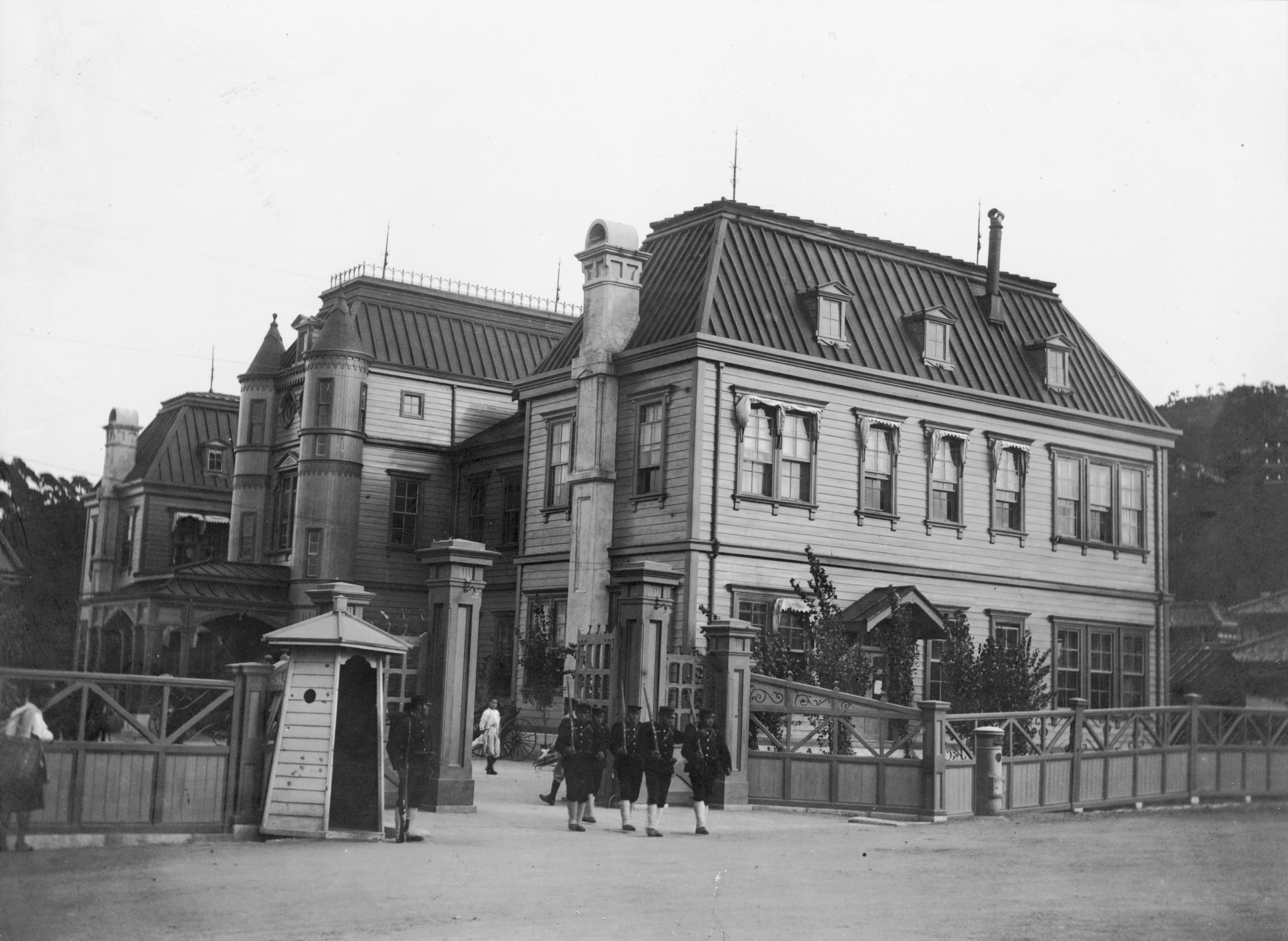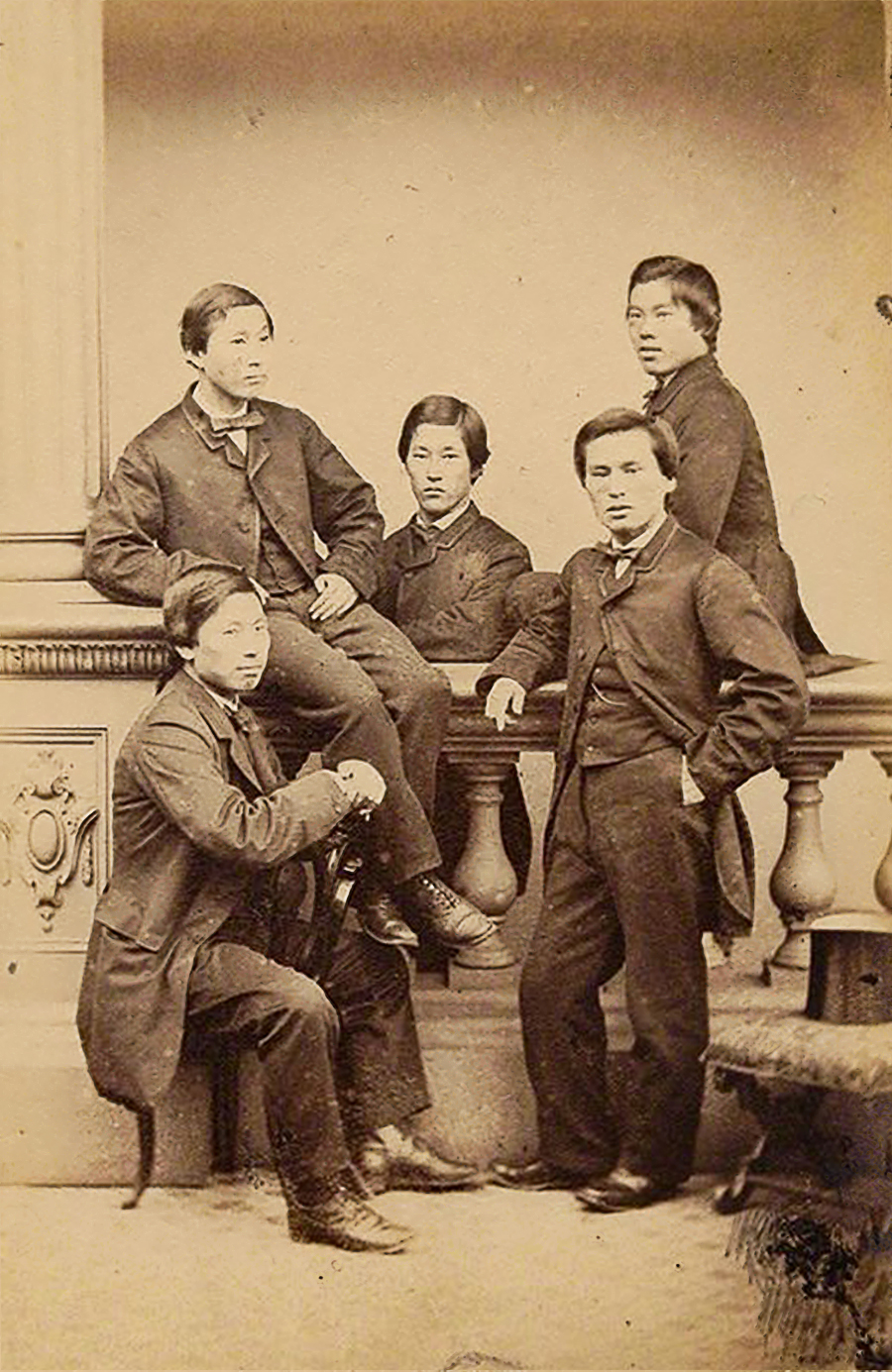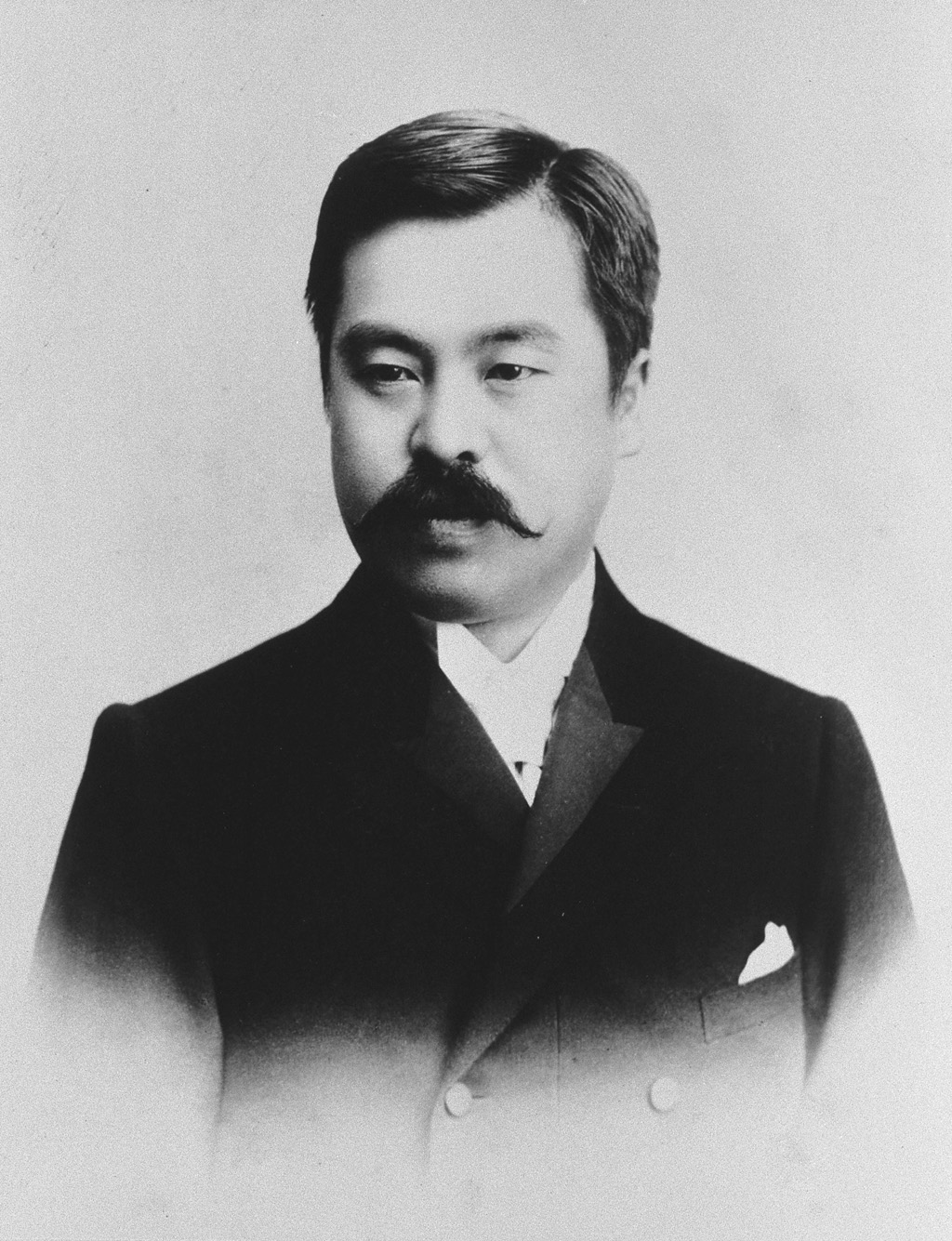|
Yamagata Isaburō
Prince was a Japanese politician, cabinet minister, and Japanese Inspector-General of Korea. His wife was the daughter of Katō Hiroyuki. Biography Katsu Isaburō was born in Nagato Province in Chōshū Domain (present-day Yamaguchi prefecture, as the second son of samurai Katsu Kanesuke and Yamagata Toshiko, the elder sister of Yamagata Aritomo. As the latter had no children, he was adopted by Yamagata Aritomo in 1861 to carry on the family name. After the Meiji Restoration, accompanied the Iwakura Mission to the United States and Europe, remaining in Germany for studies. On his return to Japan, he worked as a translator at the Foreign Ministry, and subsequently served on the Cabinet Legislation Bureau. He then entered the Home Ministry as served as Secretary to the governor of Aichi Prefecture before being appointed governor of Tokushima Prefecture, followed by Mie Prefecture. He was later promoted to Director of the Local Affairs Bureau within the Home Ministry, and rose to ... [...More Info...] [...Related Items...] OR: [Wikipedia] [Google] [Baidu] |
Senior Second Rank
The court ranks of Japan, also known in Japanese language, Japanese as ''ikai'' (位階), are indications of an individual's court rank in Japan based on the system of the Nation, state. ''Ikai'' as a system was the indication of the rank of bureaucrats and officials in countries that inherited (class system). Currently, the Japanese court ranks and titles are among the types of honours conferred to those who have held government posts for a long time and to those who have made distinguished achievements. In recent times, most appointments, if not all, are offered posthumously. A notable recipient of such a court rank is the late former Prime Minister of Japan, prime minister Shinzo Abe, who received Junior First Rank (従一位, ''ju ichi-i'') on 8 July 2022. Court ranks The national system for ranking politicians and officials who served the Japanese dynasty began in 603 when Empress Suiko enacted the Twelve Level Cap and Rank System. Each rank was identified by the color of ... [...More Info...] [...Related Items...] OR: [Wikipedia] [Google] [Baidu] |
Meiji Restoration
The , referred to at the time as the , and also known as the Meiji Renovation, Revolution, Regeneration, Reform, or Renewal, was a political event that restored Imperial House of Japan, imperial rule to Japan in 1868 under Emperor Meiji. Although there were ruling emperors before the Meiji Restoration, the events restored practical power to, and consolidated the political system under, the Emperor of Japan. The Restoration led to enormous changes in Japan's political and social structure and spanned both the late Edo period (often called the Bakumatsu) and the beginning of the Meiji era, during which time Japan rapidly Industrialization, industrialised and adopted Western culture, Western ideas and production methods. The origins of the Restoration lay in economic and political difficulties faced by the Tokugawa shogunate. These problems were compounded by the encroachment of foreign powers in the region which challenged the Tokugawa policy of , specifically the arrival of the Pe ... [...More Info...] [...Related Items...] OR: [Wikipedia] [Google] [Baidu] |
Sone Arasuke
Viscount was a Japanese politician, diplomat, cabinet minister, and second Japanese Resident-General of Korea. Biography Sone was born in Nagato Province in Chōshū Domain (present-day Yamaguchi prefecture, his adopted father was a ''samurai'' from Hagi. He fought on the imperial side in the Boshin War. After the Meiji Restoration The , referred to at the time as the , and also known as the Meiji Renovation, Revolution, Regeneration, Reform, or Renewal, was a political event that restored Imperial House of Japan, imperial rule to Japan in 1868 under Emperor Meiji. Althoug ..., Sone was sent to France for studies, and on his return to Japan served in the Ministry of War (Japan), War Ministry. Later, he served as director of the Cabinet Gazette Bureau, Secretary of the Cabinet Legislation Bureau and other posts, in 1890 he became the first Chief Secretary of the House of Representatives of Japan, House of Representatives of the first session of the Diet of Japan. Sone was ... [...More Info...] [...Related Items...] OR: [Wikipedia] [Google] [Baidu] |
Resident-General Of Korea
The Japanese resident-general of Korea (; ) was a post overseeing the Japanese protectorate of Korea from 1905 to 1910. List of Japanese residents-general See also * Governor-General of Korea * Governor-General of Taiwan The governor-general of Taiwan (, shinjitai: ) was the head of the Government-General of Taiwan in the Japanese era (including Formosa and the Pescadores) when they were part of the Empire of Japan, from 1895 to 1945. The Japanese governors- ... References {{Japan-hist-stub ... [...More Info...] [...Related Items...] OR: [Wikipedia] [Google] [Baidu] |
Itō Hirobumi
Kazoku, Prince , born , was a Japanese statesman who served as the first prime minister of Japan from 1885 to 1888, and later from 1892 to 1896, in 1898, and from 1900 to 1901. He was a leading member of the ''genrō'', a group of senior statesmen that dictated policy during the Meiji era. Born into a poor farming family in the Chōshū Domain, Itō and his father were adopted into a low-ranking samurai family. After the opening of Japan in 1854, he joined the nationalist ''sonnō jōi'' movement before being sent to England to study at University College London in 1863. Following the Meiji Restoration of 1868, Itō was appointed the junior councilor for foreign affairs in the newly formed Empire of Japan. In 1870, he traveled to the United States to study Western currency, and subsequently helped establish Japan's taxation system in 1871. Itō then set off on another overseas trip with the Iwakura Mission to the U.S. and Europe. Upon his return to Japan in 1873, he became a f ... [...More Info...] [...Related Items...] OR: [Wikipedia] [Google] [Baidu] |
Diet Of Japan
, transcription_name = ''Kokkai'' , legislature = 215th Session of the National Diet , coa_pic = Flag of Japan.svg , house_type = Bicameral , houses = , foundation=29 November 1890(), leader1_type = President of the House of Councillors , leader1 = Masakazu Sekiguchi , party1 = LDP , election1 = 11 November 2024 , leader2_type = Speaker of the House of Representatives , leader2 = Fukushiro Nukaga , party2 = LDP , election2 = 11 November 2024 , leader3_type = Prime Minister , leader3 = Shigeru Ishiba , party3 = LDP , election3 = 1 October 2024 , members = , house1 = House of Councillors , structure1 = Japan House of Councillors Political Groups - November 2024.svg , political_groups1 = Government (140) * LDP (113) * Kōmeitō (27) Opposition (91) * CDP- SDP (41) * ... [...More Info...] [...Related Items...] OR: [Wikipedia] [Google] [Baidu] |
House Of Peers (Japan)
The was the upper house of the National Diet#History, Imperial Diet as mandated under the Meiji Constitution, Constitution of the Empire of Japan (in effect from 11 February 1889 to 3 May 1947). Background In 1869, under the new Meiji government, a Japanese peerage was created by an Imperial decree merging the former court nobility ''(kuge)'' and former feudal lords (''daimyos'') into a single new Aristocracy (class), aristocratic Social class, class called the ''kazoku.'' A second imperial ordinance in 1884 grouped the ''kazoku'' into five ranks equivalent to the European Aristocracy (class), aristocrats: prince (equivalent to a European duke), marquess, count, viscount, and baron. Although this grouping idea was taken from the European peerage, the Japanese titles were taken from Chinese language, Chinese and based on the ancient Social structure of China, feudal system in China. Itō Hirobumi and the other Meiji period, Meiji leaders deliberately modeled the chamber on the ... [...More Info...] [...Related Items...] OR: [Wikipedia] [Google] [Baidu] |
Ministry Of Communications (Japan)
The was a Cabinet (government), Cabinet-level ministry in the Empire of Japan. Its modern successors include the Ministry of Internal Affairs and Communications, Japan Post and Nippon Telegraph and Telephone. History Meiji period On December 22, 1885 the Ministry of Communications was established, combining the Bureau of Posts and Shukuba, Post Station Maintenance and Shipping Bureau formerly under the Ministry of Agriculture and Commerce with the Telegraph Bureau and Lighthouse Management Bureau formerly under the Ministry of Industry. On August 16, 1891, the ministry was also placed in charge of the nascent Japanese electric power industry. On July 21, 1892, the Railway Bureau was transferred to the Ministry of Communications from the Home Ministry (Japan), Home Ministry and from November 10, 1893, the ministry was charged with the supervision of all land and water transportation businesses. However, on December 5, 1908, the Railway Bureau was separated to become an indep ... [...More Info...] [...Related Items...] OR: [Wikipedia] [Google] [Baidu] |
Saionji Kinmochi
Kazoku, Prince was a Japanese politician who served as Prime Minister of Japan, prime minister of Japan from 1906 to 1908, and from 1911 to 1912. As the last surviving member of the ''genrō'', the group of senior statesmen who had directed policy during the Meiji era, he was one of the most influential voices in Japanese politics from the mid-1920s to the early 1930s. For much of his career, Saionji worked to diminish the influence of the Imperial Japanese Army in political issues. Born in Kyoto to a noble family, Saionji took part in the Boshin War and Meiji Restoration of 1868. From 1871 to 1880, he studied European law and political institutions in France, and founded Meiji University in 1881. In 1882, Saionji again traveled to Europe with Itō Hirobumi to study constitutional law. On his return, he joined the Privy Council (Japan), Privy Council, serving as its president from 1900 to 1903, and twice served as Ministry of Education (Japan), Minister of Education in Itō's ca ... [...More Info...] [...Related Items...] OR: [Wikipedia] [Google] [Baidu] |
Mie Prefecture
is a Prefectures of Japan, prefecture of Japan located in the Kansai region of Honshu. Mie Prefecture has a population of 1,781,948 () and has a geographic area of . Mie Prefecture is bordered by Gifu Prefecture to the north, Shiga Prefecture and Kyoto Prefecture to the northwest, Nara Prefecture to the west, Wakayama Prefecture to the southwest, and Aichi Prefecture to the east. Tsu, Mie, Tsu is the capital and Yokkaichi is the largest city of Mie Prefecture, with other major cities including Suzuka, Mie, Suzuka, Matsusaka, Ise, Mie, Ise, and Kuwana, Mie, Kuwana. Mie Prefecture is located on the eastern coast of the Kii Peninsula, forming the western side of Ise Bay which features the Mouth (river), mouths of the Kiso Three Rivers. Mie Prefecture is a popular tourism destination home to Nagashima Spa Land, Suzuka International Racing Course, and some of the oldest and holiest sites in Shinto, the traditional religion of Japan, including the Ise Grand Shrine and the Tsubaki Grand ... [...More Info...] [...Related Items...] OR: [Wikipedia] [Google] [Baidu] |
Tokushima Prefecture
is a Prefectures of Japan, prefecture of Japan located on the island of Shikoku. Tokushima Prefecture has a population of 682,439 (1 February 2025) and has a geographic area of 4,146 Square kilometre, km2 (1,601 sq mi). Tokushima Prefecture borders Kagawa Prefecture to the north, Ehime Prefecture to the west, and Kōchi Prefecture to the southwest. Tokushima, Tokushima, Tokushima is the capital and largest city of Tokushima Prefecture, with other major cities including Anan, Tokushima, Anan, Naruto, Tokushima, Naruto, and Yoshinogawa, Tokushima, Yoshinogawa. Tokushima Prefecture is located on the Kii Channel, connecting the Pacific Ocean and Seto Inland Sea, across from Wakayama Prefecture on the Kii Peninsula of the island of Honshu. Tokushima Prefecture is connected to Awaji Island across the Naruto Strait by the Ōnaruto Bridge as part of the Kobe-Awaji-Naruto Expressway, connecting the prefecture to the city of Kobe and the San'yō Expressway on Honshu. History Until ... [...More Info...] [...Related Items...] OR: [Wikipedia] [Google] [Baidu] |
Aichi Prefecture
is a Prefectures of Japan, prefecture of Japan located in the Chūbu region of Honshū. Aichi Prefecture has a population of 7,461,111 () and a geographic area of with a population density of . Aichi Prefecture borders Mie Prefecture to the west, Gifu Prefecture and Nagano Prefecture to the north, and Shizuoka Prefecture to the east. Nagoya is the capital and largest city of the prefecture. Overview Nagoya is the capital and largest city of Aichi Prefecture, and the Largest cities in Japan by population by decade, fourth-largest city in Japan. Other major cities include Toyota, Aichi, Toyota, Okazaki, Aichi, Okazaki, and Ichinomiya, Aichi, Ichinomiya. Aichi Prefecture and Nagoya form the core of the Chūkyō metropolitan area, the List of metropolitan areas in Japan, third-largest metropolitan area in Japan and one of the largest metropolitan areas in the world. Aichi Prefecture is located on Japan's Pacific Ocean coast and forms part of the Tōkai region, a subregion of the ... [...More Info...] [...Related Items...] OR: [Wikipedia] [Google] [Baidu] |





